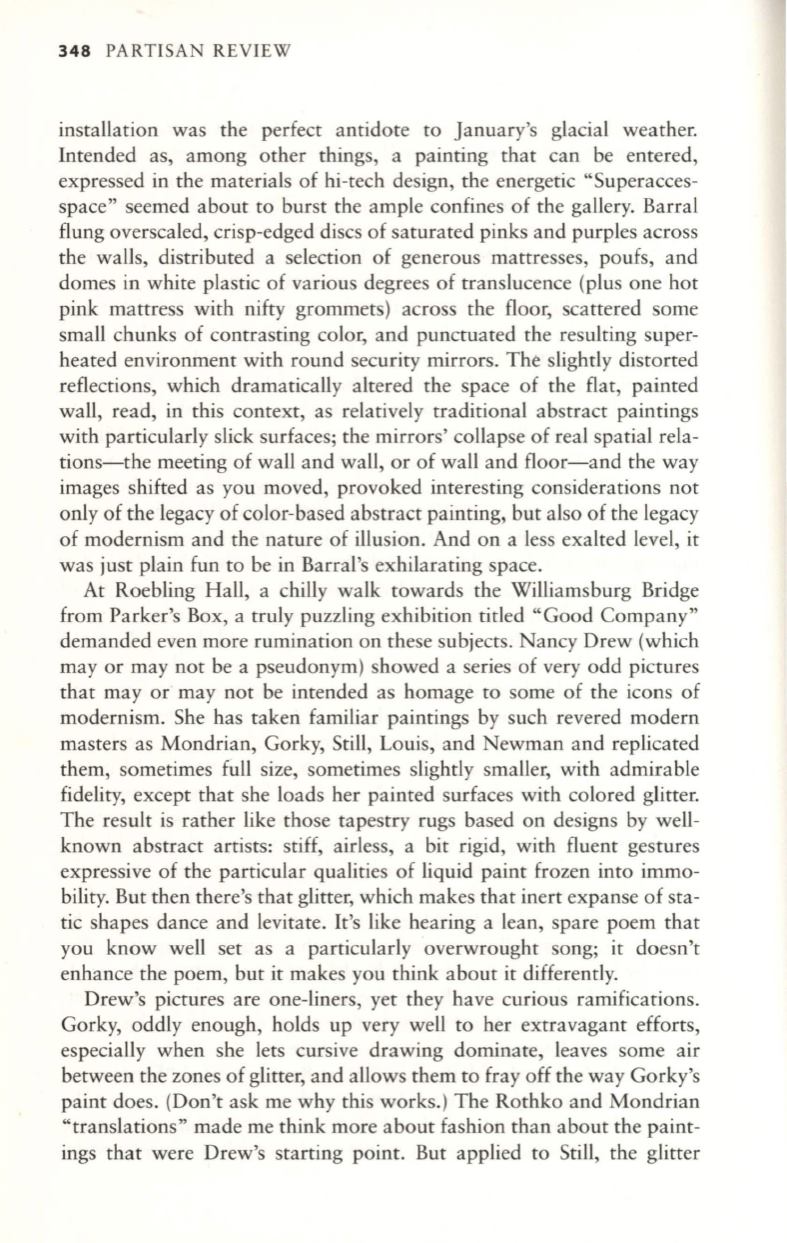
348
PARTISAN REVIEW
installation was the perfect antidote to January's glacial weather.
Intended as, among other things, a painting that can be entered,
expressed in the materials of hi-tech design, the energetic "Superacces–
space" seemed about to burst the ample confines of the gallery. Barral
flung overscaled, crisp-edged discs of saturated pinks and purples across
the walls, distributed a selection of generous mattresses, poufs, and
domes in white plastic of various degrees of translucence (plus one hot
pink mattress with nifty grommets) across the floor, scattered some
small chunks of contrasting color, and punctuated the resulting super–
heated environment with round security mirrors . The slightly distorted
reflections, which dramatically altered the space of the flat, painted
wall, read, in this context, as relatively traditional abstract paintings
with particularly slick surfaces; the mirrors' collapse of real spatial rela–
tions-the meeting of wall and wall, or of wall and floor-and the way
images shifted as you moved, provoked interesting considerations not
only of the legacy of color-based abstract painting, but also of the legacy
of modernism and the nature of illusion. And on a less exalted level, it
was just plain fun to be in Barral's exhilarating space.
At Roebling Hall, a chilly walk towards the Williamsburg Bridge
from Parker's Box, a truly puzzling exhibition titled "Good Company"
demanded even more rumination on these subjects. Nancy Drew (which
mayor may not be a pseudonym) showed a series of very odd pictures
that mayor may not be intended as homage to some of the icons of
modernism. She has taken familiar paintings by such revered modern
masters as Mondrian, Gorky, Still, Louis, and Newman and replicated
them, sometimes full size, sometimes slightly smaller, with admirable
fidelity, except that she loads her painted surfaces with colored glitter.
The result is rather like those tapestry rugs based on designs by well–
known abstract artists: stiff, airless, a bit rigid, with fluent gestures
expressive of the particular qualities of liquid paint frozen into immo–
bility. But then there's that glitter, which makes that inert expanse of sta–
tic shapes dance and levitate. It's like hearing a lean, spare poem that
you know well set as a particularly overwrought song; it doesn't
enhance the poem, but it makes you think about it differently.
Drew's pictures are one-liners, yet they have curious ramifications.
Gorky, oddly enough, holds up very well to her extravagant efforts,
especially when she lets cursive drawing dominate, leaves some air
between the zones of glitter, and allows them to fray off the way Gorky'S
paint does. (Don't ask me why this works.) The Rothko and Mondrian
"translations" made me think more about fashion than about the paint–
ings that were Drew's starting point. But applied to Still, the glitter


